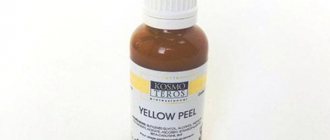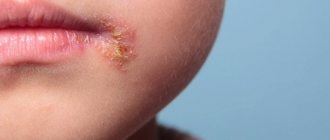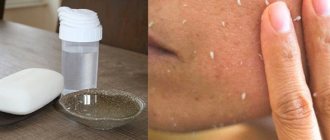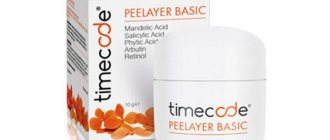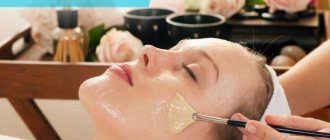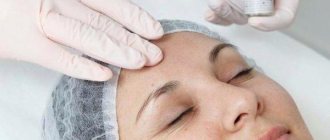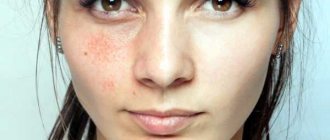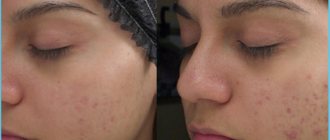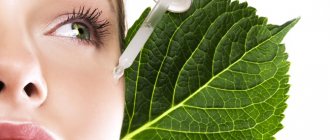From this article you will learn:
- Yellow peeling – what is it?
- Properties of yellow peeling
- How does yellow facial peel work?
- Types of yellow peeling
- What is yellow peeling with salicylic acid
- Who is suitable for yellow skin peeling?
- Contraindications to the yellow peeling procedure
- How is yellow peeling performed in the salon?
- Useful tips for those planning to undergo a course of yellow chemical peeling
- What is the correct care after the yellow peeling procedure?
- How much does yellow peeling cost?
- Is it possible to do yellow peeling at home?
Yellow peeling... This is exactly the “colored” name for retinoic peeling, which is familiar to many. It perfectly helps in the fight against age-related skin changes. During the procedure, the top layer of dead cells is exfoliated, thereby stimulating the regeneration process of the dermis.
Like any other chemical peeling, yellow peeling must be carried out under the supervision of a cosmetologist, who will not only perform the procedure correctly, but also give detailed recommendations for further care. But you will learn in our article what results can be achieved using this amazing technique.
Yellow peeling – what is it?
Among ordinary people, this procedure is better known as yellow peeling rather than retinoic peeling, due to the color of the film that forms on the face during the process. Another unofficial name for the manipulation is “weekend exfoliation,” since after the service is provided, the skin heals very quickly, literally in a couple of days. Therefore, many women make an appointment with a cosmetologist on Friday in order to come to work after the weekend with a fresh and well-groomed face without any consequences of cleansing.
Experts divide cleaning according to the degree of penetration into the skin into superficial, middle and deep, and according to the degree of impact on the dermis - into mechanical and chemical. If we talk about yellow peeling, it has a chemical effect at the surface or middle level.
Recommended articles on the topic:
- Ultrasonic facial peeling is a pleasant and beneficial procedure for your skin
- Redermalization of the skin: all the pros and cons
- Almond peeling for the face: features of the procedure
The mask contains retinol, or retinoic acid. This drug has beneficial properties that have a positive effect on the condition of the skin. It triggers intracellular processes, while gently influencing the dermis of the face.
Let's say a few words about the properties of retinoic acid.
It is close in structure and properties to vinegar. However, when in contact with facial skin, retinoic acid has a milder effect and helps exfoliate dead cells.
Indications for PRX-T33 peeling
- Acne (as an alternative to cosmetic procedures, this type of cleansing starts the process of removing purulent formations, pimples and blackheads)
- Flabbiness or loss of elasticity of facial skin
- Presence of post-inflammatory spots after acne
- Atrophic scars
- Stretches of various depths
- Seborrheic dermatitis
- An auxiliary method for the treatment of seasonal and age-related pigmentation
- Hyperkeratosis of the facial skin
- Prevention and treatment of skin photoaging
Properties of yellow peeling
Beneficial features:
- Stimulation and rejuvenation of the skin.
Retinoic yellow peeling helps improve metabolism in the dermis, stabilizes cell membranes, accelerates their regeneration, protects against harmful radicals, and forms new protein structures such as collagen and elastin.
- Improving the protective properties of the skin.
Such cleaning helps to improve and restore the natural immunity of the dermis, with the help of which it can protect itself from pathogenic microbes. Also, strong immunity promotes rapid healing of wounds.
- Restoration of epithelial tissues in a number of skin diseases.
Retinoic acid helps get rid of acne, acne, loss of pigment at wound sites, and rapid skin regeneration after burns. It helps with psoriasis and dermatitis.
- Lightening facial skin.
Retinoic yellow peeling produces a brightening effect on the skin. The components it contains block the activity of the enzyme tyrosinase, which promotes the release of melanin. Due to the increased activity of the latter, freckles, post-acne and hyperpigmentation appear on the face.
- Prevention of cancer.
There is an opinion among experts that retinoic acid, through its action, can destroy damaged and weak skin cells, preventing the formation of harmful tumors in them, which could lead to the formation of a benign or malignant tumor.
Superficial45
With this procedure, the active substances work only within the stratum corneum of the epidermis. It belongs to gentle technologies. The technique is recommended for use on young problem skin to get rid of the following problems:
- acne;
- post-inflammatory erythema;
- solar lentigo;
- actinic keratosis;
- moderately manifested photoaging;
- pigment dyschromia.
Recovery after such a procedure is not required; immediately after it you can go about your planned activities. But its effect does not last long.
For superficial peeling, the following products for acne and acne on the face can be used:
- 30-70% AHA;
- cocktails including alpha and beta hydroxy acids;
- salicylic acid with a maximum concentration of 20%
- 5-10% retinoic acid;
- Jessner's solution;
- phytic acid;
- 15% TCA.
How does yellow facial peel work?
Cosmetic manipulation renews the skin and improves the condition of your skin. However, its effect is completely different from other types of exfoliation, which tend to act on the skin from the outside, while the yellow peel solves problems by dealing with them from the inside. Let's take a closer look at this process.
To better understand the differences, let’s compare the effects of retinoic and fruit acids, namely glycolic acid. The latter grossly disrupts the outer layer of the skin, damaging it and removing dead cells, which are subsequently replaced with new ones. Retinoic acid has a milder effect on the dermis of the face, working not with cells directly, but with intercellular structures.
Retinoids do not interact with the top layer of the skin, but with the basal layer, where cells are born. Due to their structure, microparticles of the medicinal substance quickly penetrate to their destination and promote accelerated division and formation of new cells. They begin to actively move towards the surface of the skin and take the place of dead specimens, pushing them out. As a result, the dermis is exfoliated and renewed.
Thus, this composition does not act aggressively on the skin of the face, destroying old cells. On the contrary, it works from the inside and helps the emergence of new healthy specimens. Retinoic acid also helps improve the density and elasticity of your facial skin and its uniform pigmentation.
In addition to this substance, the medicinal composition also contains other components that have a positive effect on the condition of the dermis, such as:
- Phytic, kojic, azeloic acids, which help whiten the skin.
- Salicylic acid – exfoliates dead cells.
- Vitamin C fights free radicals.
- Allantoin, aloe and chamomile extracts produce a calming effect.
Here are some benefits of a cosmetic service:
- has a gentle effect on the skin, there is virtually no discomfort or burning during the procedure;
- after the first session you will be able to see a significant improvement in the condition of your dermis;
- no side effects, skin healing occurs one to two days after the procedure;
- four to five sessions will be enough to consolidate the result;
- the effect lasts for three to four months.
How to choose a chemical peel for problem skin
So in what cases is chemical peeling indicated for problem skin:
- Mild to moderately severe forms of acne
- Inactive process of appearance of new rashes
- Performed at least once every 2 weeks
Let's look at the rules for selecting peels for problem skin using the example of specific peels from the DermaQuest line of enriched peels.
Types of yellow peeling
Yellow peeling comes in two types. Cleanings differ in the amount of retinoic acid used and the time of the procedure.
Cosmetic brands offer exfoliating formulations with varying concentrations of retinoic acid. Thus, the professional product contains approximately 5–10% of this substance, as well as other auxiliary components: kojic, azeloic, phytic and other acids, which produce an additional effect, help whiten the skin, and soothe it.
The first composition contains synthetic retinoic acid, which is a high concentration of retinol. With this active substance content, the product has a deeper effect on the skin of the face. The medicinal composition is applied to the dermis twice with a break of one day. After completing the procedure, it is advisable to avoid direct sunlight, so it is recommended to do it in autumn or winter in mostly cloudy weather. Before the session, you need to prepare your facial skin.
The second composition contains natural retinoic acid, which has a more gentle effect on facial skin. Yellow cream peeling on a natural basis produces superficial cleansing of the dermis. The procedure is performed once every month, interrupted during the summer.
Contraindications
- Individual intolerance
- Violation of the integrity of the skin
- Active inflammatory process on the skin
- Herpes in active phase
- Severe somatic diseases
- Cautious use for skin types IV-V according to Fitzpatrick in the spring-summer period
- Pregnancy, lactation
- Prolonged exposure to the sun
Home care products
- Prepeel Light - pre-peeling cream
- Vegelip cream – moisturizing cream
- Postpeel Light - post-peel cream
- Cleanser mousse
Yellow peeling with salicylic acid
If you want to achieve greater results and have a few days to complete a full facial skin treatment, the yellow peeling procedure with salicylic acid is suitable for you. Before applying yellow peeling, the cosmetologist treats the dermis with salicylic acid and then applies the main composition. This manipulation promotes active peeling of dead skin cells.
Salicylic acid actively helps remove dead skin cells from the surface of the face, resulting in a more effective effect of the main composition on problem areas. If your dermis is acne-prone, you should regularly cleanse with this substance. Therapeutic components help heal inflammation and get rid of acne, improve blood circulation and cell restoration process.
We recommend
Laser aesthetic cosmetology: perfect technique for perfect appearance More details
During the procedure, you may feel a slight burning sensation due to the active effect of salicylic and retinoic acids on problem areas of your skin.
After the first session you will notice an improvement in the condition of the dermis. However, do not forget that in order to consolidate the effect, you must undergo a course of treatment. As a result of proper therapy, you will become the owner of smooth, renewed skin. This manipulation will help you:
- Smooth out superficial wrinkles and reduce deep ones.
- Lighten or completely get rid of age spots.
- Even out skin texture and tone.
- Firm and tighten the dermis of the face.
After completing the procedure and removing the composition, you may notice redness of the skin, which is a natural reaction of the body. It will soon pass. However, a couple of days after your yellow salicylic acid peel session, a process will begin in which the top layer of your face's dermis will begin to crack and peel off.
Don’t be alarmed – this is how dead skin cells are removed from the surface so that their place can be taken by renewed and healthy cells. Of course, your appearance may raise many questions and not the most pleasant attention from colleagues and acquaintances. The use of concealing cosmetics will not help you much, and their use is not recommended, as it can limit the access of oxygen to new skin cells. Therefore, it is better to do yellow peeling at a time when you have a few free days to spend in peace at home.
As you know, salicylic acid dries the skin, so this manipulation is not recommended for people with dry skin. If you have thin and sensitive skin, the procedure may be harmful. Yellow peeling with acid is indicated for those with oily and combination skin types.
To consolidate the result, a course of three procedures should be carried out every two weeks. Next, you need to perform prophylaxis every three months.
Pumpkin peeling Basic
Basic pumpkin peeling is a combination of AHA (glycolic and lactic acids 3%), salicylic acid 2% and pumpkin pulp 40% - a source of natural vitamin A.
Dissolves comedones (blackheads), shrinks pores, has a steaming effect, and also has a strong anti-inflammatory, anti-edematous, absorbable effect, helping to solve a wide range of problems:
• Thick seborrhea – dense comedones due to tight, dense sebum;
• Single inflammatory elements (papules and pustules);
• No age-related changes;
• Hyperkeratosis, “dirty” skin color;
Performs the function of atraumatic skin cleansing , reduces sebum production.
Clinically proven results: 87% reduction in breakouts with the DermaQuest Pumpkin Peel.
* Are you interested in real results and the opinions of cosmetologists about Atraumatic skin cleansing using Basic pumpkin peeling? Read here .
Who is suitable for yellow skin peeling?
Retinoic yellow peeling is an almost universal cosmetic procedure that allows you to cope with many skin imperfections.
In addition to the usual set that any other exfoliation has, namely getting rid of dullness, greasiness and uneven surface of the dermis, yellow peeling will help you in the fight against:
- wrinkles;
- age spots;
- photoaging;
- decreased turgor;
- thickening of the stratum corneum.
As a rule, most often this cosmetic procedure is performed by women after 40 years of age with the appearance of age-related changes on the face. If you have acne or acne marks, you are also recommended to use this service.
Thanks to its medicinal composition, yellow peeling improves skin condition and helps:
- deeply cleanse the dermis, while producing an antibacterial effect that prevents the development of acne;
- stimulate the production of collagen and elastin, tighten facial contours and smooth out wrinkles;
- even out skin color, making it healthy and matte;
- lighten freckles, age spots and post-acne.
This cosmetic service is recommended for you if you:
- withered dermis, there are wrinkles;
- the sebaceous glands are too active;
- dry skin type;
- there are defects on the face (pits, scars, etc.);
- there are pimples, comedones, blackheads;
- unhealthy complexion.
As you can see, yellow peeling helps fight many skin diseases, so it can be performed by anyone who in one way or another wants to improve the condition of their skin.
Glycolic peeling with phytic and kojic acid
Glycolic peeling with phytic and kojic acid with antioxidant properties, designed to eliminate superficial hyperpigmentation, as well as comprehensively combat the signs of photoaging.
The phytic acid it contains enhances exfoliation and has a more gentle effect, and kojic acid blocks the synthesis of melanin, the pigment responsible for skin color. Indications for use:
- hyperpigmentation;
- aesthetic problems in patients with dark skin;
- a combination of problems with skin aging and hyperpigmentation.
Contraindications to the yellow peeling procedure
Before carrying out the procedure, you must consult a cosmetologist. This manipulation has a number of contraindications, so you should find out in advance whether this service is right for you or whether it is not worth doing.
Yellow facial peeling is not recommended if you have:
- Allergy. By its effect on the skin of the face, retinol triggers an accelerated metabolism and makes the dermis more sensitive. If you have previously had allergic reactions, then after exfoliation there is a high probability of a relapse of the disease.
- Viruses and infections. For the reasons described above, the risk of developing pathologies caused by the activity of harmful microorganisms also increases. Most often, herpes may develop after the procedure.
- Photosensitivity. If your skin is sensitive to ultraviolet rays, it may burn after exfoliation.
- Liver diseases. The active components of the medicinal composition not only interact with skin cells, but also partially enter the blood and then the liver. If you have pathologies of this organ, retinoic acid can cause negative consequences.
- Skin diseases. If your dermis is damaged or can suffer from the slightest impact, you are not recommended to undergo the procedure, as it can cause burns and additional injuries.
- Pregnancy and lactation. The active component of yellow peeling - retinol - can negatively affect the health of the baby in the womb, so you should refrain from using the service a year before the expected pregnancy, while pregnant, and also during lactation.
- Taking certain medications. For example, if you take Roaccutane or other medications that are similar in composition and purpose, this service is not indicated for you during the course.
- Neoplasms. If you have a tumor on your face, it is not recommended to do yellow peeling, as exposure to it may cause it to grow.
Remember that you can do yellow peeling only if you have no contraindications. Even if you plan to perform this procedure at home, be sure to consult a specialist first.
How is yellow peeling performed in the salon?
This cosmetic procedure will help you renew your skin, make it fresh and shiny, get rid of dead cells and acne areas. Let's take a closer look at how yellow peeling is done in the salon.
Stage 1. Preparation.
It is strongly recommended that the procedure be performed only by a specially trained technician. Of course, you can buy yellow peeling to do it yourself at home, but in this case the responsibility will lie entirely with you, since if the subtleties are not followed or the dosage is incorrect, there is a high risk of negative consequences.
Before visiting a cosmetologist, you need to prepare your skin in a certain way:
- Use skincare products daily with a percentage of retinoic acid of 0.025–0.1%.
- Temporarily refrain from sunbathing and tanning.
If you have a fair skin type, start this preparation two weeks before the procedure. For those with dark skin, it is recommended to increase the duration of this stage to four weeks. This is due to the fact that dark skin is more sensitive to the active components of the composition.
We recommend
How to get rid of unwanted hair quickly, painlessly and forever Read more
Before starting the session, the cosmetologist must conduct a test for an allergic reaction. If the skin has not shown a negative response, you can safely proceed to the main stage.
Stage 2. Carrying out the procedure.
Yellow peeling, application protocol:
- The specialist cleanses the skin of cosmetics, dust and all types of impurities.
- Then the dermis must be wiped with salicylic or glycolic acid to superficially remove dead cells from the surface of the face. After such cleansing, the main composition will be easier to penetrate into problem areas.
- The main preparation is applied to the face using a brush.
- The medicinal composition is kept on the skin for 15 minutes. During the first procedure, it is recommended to use a product with a reduced concentration of retinol to adapt the dermis and eliminate the risk of chemical burns. In this case, the composition can be left on the face for up to 12 hours.
- 15 minutes after application, the drug hardens and forms a yellow film. After the procedure is completed, it must be removed. If you need to let the compound sit for several hours, you will have to remove it at home yourself.
After exfoliation, you should apply a protectant to your skin to act as a barrier to harmful ultraviolet rays.
There are chemical peels that can be used for inflammation on the face. What are their features and what role do they play in the complex treatment of acne? The story is told by Natalia Anatolyevna Polonskaya, Candidate of Medical Sciences, Associate Professor of the Department of Skin and Sexually Transmitted Diseases at the Faculty of Advanced Training of Physicians of the Russian State Medical University, Chief Physician of the Optimed Aesthetic Medicine Corporation.
— In what cases are chemical peels used to treat acne?
Peeling is not the main treatment for acne. And you shouldn’t think that a couple of such procedures will help get rid of acne forever. But in the hands of an experienced specialist, peeling can serve as an effective tool for solving specific problems.
For example, in the presence of comedones, peeling helps cleanse and reduce pores. Thanks to this, there is a reduction in rashes.
For inflammatory forms of acne, peeling lightens congestive and age spots. For post-acne, it reduces the severity of scars, evens out the texture and color of the skin.
It is best to carry out peeling under the guidance of a dermatocosmetologist who is fluent in all acne treatment methods, including aesthetic correction. After all, it is very important to correctly integrate peeling procedures into the overall treatment plan. In this case, the individual characteristics of the skin, the severity of the disease and many other factors, including financial capabilities, must be taken into account.
— What characteristics should a peeling used to treat acne have?
— Acne itself causes skin damage and the formation of permanent defects: spots, scars, enlarged pores. Therefore, the general requirement for peelings is high efficiency, but at the same time minimal trauma. In order to ensure this combination, combined peelings are used. They include anti-inflammatory and antioxidant components.
In addition, special pre-peeling preparation and post-peeling rehabilitation are of particular importance. The technology of the procedure itself, of which peeling is a part, is also important.
For example, for closed comedones (milia, “prosyanka”), we recommend starting to use a special lotion for home use 2-4 weeks before the procedure. It liquefies sebum and enhances the absorbable peeling effect. And during the procedure in such cases, we always use a product that facilitates the evacuation of the contents of closed comedones.
If peeling is carried out against the background of the use of retinoids, which themselves lead to peeling and irritation of the skin, we choose the least traumatic composition for the skin and carry out rehabilitation (recovery) already during the procedure. In such cases, it is also necessary to prescribe special restorative drugs for home use during the post-peeling period.
There are many similar examples that can be given. It is clear that to fully carry out peeling procedures for acne, you need a whole arsenal of tools, knowledge and skills. Therefore, specialists should have not one, but many preparations for peeling, pre-peeling and post-peeling rehabilitation on their desks. You can’t skimp on this if you really want to help the majority of patients.
— Is it possible to perform this procedure on an inflamed face?
— Traditionally, the inflammatory process is considered a contraindication for peeling. However, together with the laboratory with which we have been cooperating for many years, we were able to develop new compositions and technologies that allow us to successfully carry out procedures for the most severe forms of acne.
Of course, the effectiveness and safety of these methods have been carefully studied. In particular, my dissertation is devoted to the use of peelings for inflammatory forms of acne. And the method itself is protected by an international patent.
The question arises: why exactly so much effort? Is it really so important to ensure the possibility of using peelings for inflammation? I will answer briefly. Carrying out anti-inflammatory peeling in the early stages of treatment prevents the appearance of irreversible skin defects, including spots and scars. In addition, such peeling accelerates the achievement of an aesthetic result, and this gives the patient hope that the treatment will be successful and significantly improves his psychological state.
In addition, correctly selected and performed procedures in some cases make it possible to reduce the dosage and timing of use of systemic drugs. In addition, the severity of existing skin changes decreases.
— Is this peeling suitable for treating acne in adulthood?
— Of course, and in this case it allows you to solve several problems at the same time. After all, along with acne treatment, age-related changes are corrected.
Acne often occurs over a long period in patients of this age group. Therefore, as a rule, the skin has an uneven texture and color, enlarged pores and capillaries, and pronounced scars. Peeling helps correct these defects. And this, in turn, leads to achieving a visible rejuvenation effect.
— What measures, in addition to peelings, need to be taken to treat acne? What's new in this area?
— Nothing fundamentally new in the treatment of acne has appeared in recent years and, most likely, will not appear in the near future. Currently, existing treatment methods are being improved and the most effective combinations are being studied.
Antibiotics, antiandrogens and retinoids are still the main means of treatment. Moreover, the palm in terms of effectiveness and duration of preservation of the effect, of course, belongs to retinoids for systemic use.
Peeling can be successfully combined with any of the listed types of treatment.
— Many people suffering from acne are afraid to use antibiotics and retinoids for fear of their side effects. How justified is such fear?
“We should be afraid of unqualified and indifferent specialists.” In addition, it is dangerous and most often useless to self-medicate. After all, that drug that you heard about in an advertisement or from a friend can, if used incorrectly, not only not help, but also harm you.
As for antibiotics, retinoids and other drugs, a competent dermatologist will always weigh the possible benefits and risks and select the optimal treatment regimen. There are no absolutely harmless drugs. Even green tea has side effects if consumed in moderation.
When retinoids are used correctly, the positive effect is incomparable to completely tolerable and controllable adverse reactions. By the way, it was the desire to reduce the severity of the side effects of retinoid therapy that was one of the main reasons for creating a complex treatment method using anti-inflammatory peeling, which we discussed above.
— How soon after starting acne treatment does a visible result occur?
If we talk about peelings, most patients receive visible results after the first procedure. But this, unfortunately, does not guarantee the durability of the effect.
If, within two months after external treatment, fresh rashes appear with the same intensity, you need to think about using complex therapy. This is necessary in order not to multiply post-inflammatory skin changes.
It makes sense to rely only on external treatment during existing or planned pregnancy, acute hepatitis, renal or liver failure, and during periods of prolonged uncontrolled exposure to the sun.
Comprehensive treatment results in sustained improvement after an average of six to eight weeks. A longer time to obtain the effect is required for patients with multiple closed comedones, fistulous tracts, severe hormonal disorders, and concomitant atopic dermatitis.
In any case, it is necessary to prepare yourself for a course of treatment lasting at least four to six months.
Is it always possible to defeat acne?
Unfortunately, acne cannot be cured once and for all, because it is associated with genetically determined characteristics of the sebaceous glands, disruption of the functioning of epidermal cells, and the state of the endocrine system. For some it happens more often, for others less often, for some it is easier, for others it is more severe, but exacerbations will occur.
However, we are quite capable of controlling the disease and preventing the development of severe forms and irreversible skin defects. Now we can teach a patient with acne to always look decent.
What should those who have dealt with acne do to prevent this problem from returning?
Oily problem skin will always require special attention. This, by the way, has its advantages: a person who has been accustomed to taking care of his skin since adolescence has a better chance of looking well-groomed. Therefore, after treatment, each patient is given an individual regimen for using medications at home, depending on the type and condition of the skin. For those who find it difficult to regularly visit a cosmetologist, we have even developed a special “Beauty Salon at Home” program.
It is very important to limit the excessive use of makeup, especially thick and low-quality makeup. And for those who, due to professional necessity, are often forced to put on makeup, a special regime and combination of products are selected for complete cleansing and restoration of the skin.
In addition, it is advisable not to injure the skin by trying to squeeze out each comedone. This is a thankless task that will only add new problems to you.
If an exacerbation occurs, you need to consult your doctor, find out the cause and develop behavior and treatment tactics. It is important to do this as quickly as possible to prevent new scars and blemishes from forming.
Useful tips for those planning to undergo a course of yellow chemical peeling
- Contact only those specialists who have the necessary qualifications to perform the yellow peeling procedure with retinol. The quality of the service provided and your health directly depend on this.
- Pay attention to the cleanliness of the office and the sterility of the equipment.
- Before the procedure, the cosmetologist must conduct a consultation, during which he can check the condition of your skin for any contraindications to the procedure, and give recommendations for preparation.
- Listen to all expert advice. Remember that the final result depends on the correct adherence to the stages of the procedure.
- For some time after the session, try to avoid direct sunlight and refrain from going to the solarium.
- It is recommended to do the procedure in autumn or winter, when the weather is mostly cloudy and the risk of exposure to ultraviolet radiation is reduced. During the rest of the year, exposure to the sun can lead to premature photoaging of the skin and the appearance of age spots.
- How long to do yellow peeling? To consolidate the result, it is necessary to undergo a course of treatment of three sessions every two to three weeks. However, if you have minor facial skin problems, one procedure may be sufficient.
- You should not perform exfoliation if you are planning an event or public presence in the near future. After the service is provided, an unexpected allergic reaction may occur or the skin recovery time may increase, which may negatively affect your appearance.
- Assess all negative complications that may arise after the procedure.
- After the end of the session, it is advisable to get home by your own transport or by taxi. Since the composition is kept on the face for six hours or more, you will have to return to your place with the applied drug.
- There is an opinion that the active component of yellow peeling, retinol, can be harmful to health. This possibility cannot be excluded, however, for this to happen, the concentration of the substance must be enormous, which is impossible with this procedure, since a negligible amount of retinol enters the blood through the skin, which is then excreted from the body in the shortest possible time.
- Sometimes on the Internet you can find negative reviews about yellow peeling, the effect of which turned out to be insignificant. This is only possible with thick skin, since in this case the active components of the substance cannot penetrate through the dense structure to problem areas. To get the result, you must first do regular exfoliation, which will help remove the stratum corneum of the dermis and facilitate the penetration of the active substance.
It is worth remembering that yellow peeling, due to its effect on the skin, can lower your immunity and increase the risk of skin infection with various infections. As a result, herpes may appear. To avoid such consequences, the cosmetologist prescribes a course of medications before the procedure that are aimed at strengthening your immunity.
After the session, the following reactions may occur in some areas of the skin:
- redness;
- burning;
- increased sensitivity;
- slight swelling.
As a rule, all these phenomena disappear within a day or two after the procedure.
You can do yellow facial peeling only if you have serious skin problems and only in a salon with a professional cosmetologist in order to avoid negative consequences after the manipulation.
Effects of AHA Fruit Peel
During recovery, the state of the epidermis changes. Chemical acids dissolve dead cells that accumulate on the surface of the epidermis, so that after the first procedure the face becomes fresher and brighter. And after the course, visible changes are noted:
- smoothing out small wrinkles;
- pronounced hydration;
- increased elasticity;
- reduction in fat content;
- reducing the number of blackheads;
- evens out complexion and eliminates hyperpigmentation.
“The main effect of peeling with fruit acids is the reduction of hyperpigmentation,” continues cosmetologist Olga Degtyareva. — If you have age spots, you can take a course of peelings to even out your complexion. It is impossible to predict the number of procedures in advance, since exfoliation occurs differently in each patient and the depth of the pigment is different. But the right concentration of the substance and a sufficient duration of the course will help get rid of this problem.”
Proper skin care after yellow peeling procedure
After the procedure is completed, a period of rehabilitation and restoration of the skin begins. At this time, you may experience:
- dryness and peeling of the dermis;
- itching;
- redness;
- swelling;
- rash (with liver pathologies).
Usually these consequences completely disappear within two to three days after the procedure. Within a week of doing the yellow peel, the peeling will completely stop and you will get rid of dead skin cells.
After performing yellow peeling, care for the dermis is necessary:
- use sunscreen regularly;
- Wash your face daily with light cleansers that do not contain alkalis or acids;
- To moisturize, periodically treat your facial skin with thermal water.
In order for the dermal restoration process to be completed as quickly as possible, the following recommendations must be followed:
- do not try to get rid of flaky skin on your own, as scarring may form;
- refrain from visiting the sauna and bathhouse, as well as swimming in a pool or open water to avoid the risk of infections;
- Avoid sunbathing and visiting a solarium;
- refrain from drinking alcohol and spicy foods, as well as medications that contain retinol.
Follow these recommendations for the first five to seven days. Try to be more gentle with your skin for a month after the procedure.
After the end of the recovery period, you will become the owner of a smooth and velvety dermis, an even complexion. Pigment spots and post-acne will be significantly lighter, wrinkles will be smoothed out, and the skin will be tightened. Below you can see before and after photos of the yellow peel.
The first two procedures must be carried out every two weeks. The next two sessions are in four weeks. In the future, it is advisable to perform preventive manipulations every four months.
If during the rehabilitation period your skin turns red and experiences unpleasant itching, try to soothe it with special cosmetics or herbal lotions.
Also, to get rid of uncomfortable sensations, a mask made from oatmeal and milk (cereals must first be crushed) will help you. You can brew chamomile or linden flowers and rinse your face with the prepared tinctures.
Advantages
This peeling can be used even during periods of high solar activity. In the summer, when systematically using glycolic peels, experts recommend giving preference to Glycolicpeel Whitening.
A product from the glycolic peeling group. It is used to eliminate superficial hyperpigmentation or for a comprehensive solution to the problem of skin aging in cases where, in addition to signs of aging, the patient exhibits hyperpigmentation:
- phytic acid: enhances exfoliation, has a less pronounced irritating effect;
- kojic acid: tyrosinase inhibitor, binds ions of 2-valent iron, necessary for the synthesis of melanin, has an antioxidant effect
How much does yellow peeling cost?
Depending on what type of peeling you do and what brand of product you use, the price of yellow peeling also changes. During the consultation, the cosmetologist will create an individual treatment plan for you with preparatory procedures.
The average cost of peeling is 4,500–8,000 rubles.
Currently, there are a huge number of manufacturers offering medicinal compositions for performing manipulation. You can buy any brand of yellow facial peel for the procedure.
Here are some popular brands that offer the best yellow peeling: GIGI (Israel), CosMedix (USA), SesDerma (Spain), etc.
The cost of a session using these compounds will be approximately 10,000 rubles.
Deep45
Deep peeling affects the papillary dermis. During the session, the cosmetologist uses an anesthetic, since the procedure itself is a chemical burn, after which skin regeneration occurs. Most often, this method is used to remove deep wrinkles, scars, including post-acne. The rehabilitation period is approximately 5 months. The effect lasts for several years.
The procedure is carried out using the following substances:
- 35-50% TCA;
- phenol.
Before the procedure, the specialist collects anamnesis, studies the type and characteristics of the skin. Only after this the doctor will be able to select an effective remedy for acne on the face and the number of procedures.
Is it possible to do yellow peeling at home?
Of course, you are wondering how to make yellow peeling at home. However, there is no answer to this. This procedure is strongly recommended to be carried out in beauty salons. Since retinol has serious effects on the skin at the mid-level, this service should be provided under the supervision of a professional technician.
If the procedure is carried out incorrectly at home, negative consequences may arise, such as skin pigmentation, which will then have to be dealt with for a very long time.
Only a specialist can choose the correct dosage of the composition specifically for your skin type.
Let us repeat once again that yellow facial peeling is a professional cosmetic procedure that is contraindicated to be done at home.
On your own, you can only use cosmetics that contain retinol. Such products affect the skin at a superficial level and promote gradual and gentle renewal of the dermis.
But even when using such formulations, it is necessary to strictly follow all the recommendations described in the instructions for the drug.
Nowadays, you no longer have to spend a lot of time performing complex and unpleasant procedures at home. It is much easier to seek help from real professionals - the Veronika Herba beauty and health center, equipped with effective and modern equipment.
Why clients choose Veronika Herba beauty and health center:
- This is a beauty center where you can undergo a cupping massage course at a reasonable cost, while your face and/or body will be treated not by an ordinary cosmetologist, but by one of the best specialists in Moscow. This is a completely different, higher level of service!
- You can receive qualified help at any time convenient for you. The beauty center is open from 9:00 to 21:00, seven days a week. The main thing is to agree with your doctor in advance on the date and time of your appointment.
Sign up for a consultation with a specialist by phone +7 (495) 085-15-13, and you will see for yourself!
Pumpkin peeling Powerful
Powerful pumpkin peeling differs from the main peeling in a higher percentage of AHA: glycolic and lactic acids 10% each, which gives deeper penetration of the remaining active ingredients.
Indications:
• All previous readings
• Anti-aging effect
Recommended for thicker skin with a good barrier function or high activity of the sebaceous glands. Effective for deformation type of aging , also indicated for the problem of late acne.
A video demonstrating the Pumpkin Peeling procedure can be found at this link .

